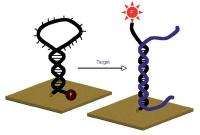October 5, 2009 weblog
Rapid DNA Detection Quickly Diagnoses Infections

Credit: Benjamin Miller, University of Rochester Medical Center
(PhysOrg.com) -- A new portable device can detect bacteria and help prevent the spread of infectious diseases. This new tool takes from 15 minutes to 2 hours to diagnose a patient for infectious diseases and can be used in hospitals, doctor's office and at home.
Diagnosing bacterial infections today requires growing cultures in a lab. This process takes days but with this new type of DNA sensor, common bacterial infections can be diagnosed within an hour or two.
The new ultrafast DNA nanosensor is based on various nanomaterials that are under development for ultrasensitive, fast DNA detection.
Each nanosensor contains a folded strand of DNA, which is complementary to the genetic sequence being targeted. The DNA strand remains folded until a target genetic sequence is linked to it. By using disposable cartridges with the nanosensor, blood or urine samples can be placed directly on the cartridge for testing.
Benjamin Miller a professor and biomedical engineering at the University of Rochester Medical Center stated: "In the cartridge there are steps for cleaning up samples, that is, extracting material you're interested in and amplifying the bacterial DNA". The cartridge is then placed in a small portable device for analysis. The disposable cartridges would only cost a few dollars, thereby making it economical.
By placing different DNA strands in cartridges, you can test for multiple pathogens. Researchers have developed sensors to detect antibiotic-resistant staph bacteria that cause skin infections.
Researchers are working on other sensors for rapid DNA detection that uses carbon nanotubes, nanowires, and nanoparticles. All these methods promise low cost and high accuracy.
Michael Strano, a chemical engineering professor at MIT stated: "If you could make a portable device that would sit in your doctor's office, then, using a small amount of fluid, your doctor could screen you for a genetic abnormality".
Via: Technology Review
© 2009 PhysOrg.com















